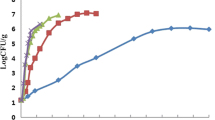Abstract
This study was conducted to develop predictive models for the growth of Staphylococcus aureus on Korean style cooked foods (potato salad, stir-fried boiled fish paste, seasoned baby aster, and stir-fried anchovies) as a function of various storage temperatures (from 15 to 35 °C). The modified Gompertz equation was applied to fit the growth curves. Potato salad, stir-fried boiled fish paste, and seasoned baby aster showed the greatest specific growth rate by 1.219, 0.782, and 1.282 log10 CFU/h and the shortest lag time by 0.283, 0.407, and 0.374, respectively, when stored at 35 °C. No growth of S. aureus was observed in stir-fried anchovies due to its low water activity. Subsequently, these results were employed to establish the secondary models, which were further used for validation using accuracy factor and bias factor. Overall, accuracy factor of less than 1.461 and bias factor of less than 1.093 were observed depending on different storage temperatures and a sort of contaminated food samples. These results will be used to develop the manual representing the safe storage period of Korean foods contaminated with pathogenic bacteria.


Similar content being viewed by others
References
Altekruse ML, Cohen ML, Swerdlow DL (1997) Emerging foodborne disease. Emerg Infect Dis 3:285–293
Bae HJ (2006) Analysis of contamination of bacteria from raw materials, utensils and workers’ hands to prepared foods in foodservice operations. J Korean Soc Food Sci Nut 35:655–660
Centers for Disease Control and Prevention (2013) Surveillance for foodborne disease outbreaks-the United States, 2009-2010. Available from: http://www.cdc.gov/mmwr/preview/mmwrhtml/mm6203a1.htm?S_cid=mm6203a1_w.013. Accessed 15 Feb 2015
Chirife J, Vaamonde G, Scarmato G (1982) On the minimal water activity for growth of Staphylococcus aureus. J Food Sci 47:2054–2057
Dalgaard P, Jørgensen LV (1998) Predicted and observed growth of Listeria monocytogenes in seafood challenge tests and in naturally contaminated cold-smoked salmon. Int J Food Microbiol 40:105–115
Ding T, Shim YH, Choi NJ, Ha SD, Chung MS, Hwang IG, Oh DH (2010) Mathematical modeling on the growth of Staphylococcus aureus in sandwich. Food Sci Biotechnol 19:763–768
Ding T, Shim YH, Kim HN, Ha SD, Chung MS, Hwang IG, Oh DH (2011) Development of predictive model for the growth of Staphylococcus aureus in Kimbab. Food Sci Biotechnol 20:471–476
Ding T, Wang J, Forghani F, Ha SD, Chung MS, Bahk GJ, Hwang IG, Abdallah E, Oh DH (2012) Development of predictive models for the growth of Escherichia coli O157:H7 on cabbage in Korea. J Food Sci 77:M257–M263
Fujikawa H, Morozumi S (2006) Modeling Staphylococcus aureus growth and enterotoxin production in milk. Int J Food Microbiol 23:260–267
Gibson AM, Bratchell N, Roberts TA (1998) Predicting microbial growth: growth response of Salmonella in a laboratory medium as affected by ph, sodium chloride and storage temperature. Int J Food Microbiol 6:155–178
Jørgensen HJ, Mathisen T, Løvseth A, Omoe K, Qvale KS, Loncarevic S (2005) An outbreak of staphylococcal food poisoning caused by enterotoxin H in mashed potato made with raw milk. FEMS Microbiol Lett 252:267–272
Kang KA, Kim YW, Yoon KS (2010) Development of predictive growth models for Staphylococcus aureus and Bacillus cereus on various food matrices consisting of ready-to-eat (RTE) foods. Korean J Food Sci Anim Resour 30:730–738
Kenny JG, Ward D, Josefsson E, Jonsson I, Hinds J, Rees HH, Lindsay JA, Tarkowski A, Horsburgh MJ (2009) The Staphylococcus aureus response to unsaturated long chain free fatty acids: survival mechanisms and virulence implications. PLoS ONE 4:e4344
Lee JY, Kim YS, Shin DH (2002) Antimicrobial synergistic effect of linolenic acid and monoglyceride against Bacillus cereus and Staphylococcus aureus. J Agric Food Chem 50:2193–2199
Mainous AG, Hueston WJ, Everett CJ, Diaz VA (2006) Nasal carriage of Staphylococcus aureus and methicillin-resistant S. aureus in the United States, 2001–2002. Ann Fam Med 4:132–137
Ministry of Food and Drug Safety (2013) The report of foodborne illness in Korea. Available from: http://www.mfds.go.kr/e-stat/index.do?Nmenucode=31. Accessed 15 Feb 2015
Montville TJ, Matthews KR (2008) Food microbiology: an introduction. ASM Press, Washington, DC, pp 189–199
Park SY, Seo KY, Ha SD (2007) A response surface model based on absorbance data for the growth rates of Salmonella enterica Serovar Typhimurium as a function of temperature, nacl, and pH. J Microbiol Biotechnol 17:644–649
Park HS, Sung BY, Ryu K (2012) Predictive model for growth of Staphylococcus aureus in blanched spinach with seasoning. J Korean Soc Appl Biol Chem 55:529–533
Ross T (1996) Indices for performance evaluation of predictive models in food microbiology. J Appl Bacteriol 81:501–508
Rural Development Administration (2015) Korean traditional food recipes. Available from: http://www.nongsaro.go.kr/portal/ps/psz/psza/contentMain.ps?menuId=PS00148&pageUnit=12. Accessed 13 May 2015
Ser JH, Kim MN, Chung YH, Kim GS (1996) Sanitary conditions of sliced squid bokum and anchovy bokum available in the market. J Food Hyg Saf 11:171–176
Simon SS, Sanjeev S (2007) Prevalence of enterotoxigenic Staphylococcus aureus in fishery products and fish processing factory workers. Food Cont 18:1565–1568
Tatini SR (1973) Influence of food environments on growth of Staphylococcus aureus and production of various enterotoxins. J Milk Food Technol 36:559–563
Te Giffel MC, Zwietering NH (1999) Validation of predictive models describing the growth of Listeria monocytogenes. Int J Food Microbiol 46:135–149
Troller JA (1972) Effect of water activity on enterotoxin A production and growth of Staphylococcus aureus. Appl Environ Microbiol 24:440–443
Yoon YH (2010) Principal theory and application of predictive microbiology. J Food Sci Ind 43:70–74
Zaika LL, Engel LS, Kim AH, Palumbo SA (1989) Effect of sodium chloride, pH, and temperature on growth of Shigella flexneri. J Food Prot 54:424–428
Acknowledgments
This research was supported by Chung-Ang University scholarship grant in 2015.
Author information
Authors and Affiliations
Corresponding author
Rights and permissions
About this article
Cite this article
Yoon, JH., Bae, YM. & Lee, SY. Predictive modeling on the growth of Staphylococcus aureus inoculated on Korean style cooked foods stored at various temperatures. J Korean Soc Appl Biol Chem 58, 693–701 (2015). https://doi.org/10.1007/s13765-015-0093-z
Received:
Accepted:
Published:
Issue Date:
DOI: https://doi.org/10.1007/s13765-015-0093-z




